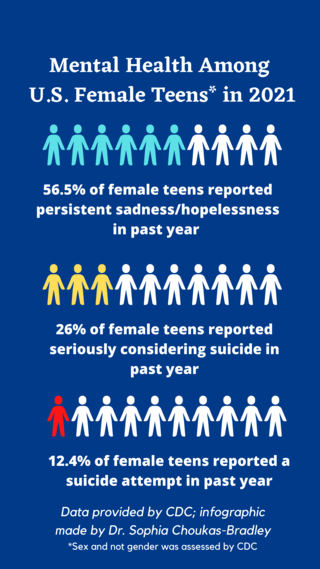Health
The Full Extent of the Teen Mental Health Crisis
Alarming new findings on female and LGB teens in particular.
Posted May 2, 2022 Reviewed by Devon Frye
Key points
- The CDC released a report on the teen mental health crisis, using 2021 nationally representative data from U.S. high school students.
- 44 percent of teens reported persistent feelings of sadness and hopelessness, similar to symptoms of major depressive disorder.
- 20 percent of teens reported seriously considering attempting suicide and 9 percent reported attempting suicide in the past 12 months.
- Female and LGB teens were at high risk (e.g., 26 percent of LGB teens reported past-year suicide attempts)—but gender identity was not assessed.
You’ve probably seen news stories in recent weeks about the CDC’s new report on the teen mental health crisis (Jones et al., 2022). Teen mental health concerns are at an all-time high, with female teens and lesbian, gay, and bisexual (LGB) teens at especially high risk.
News media reports typically skip the details. A closer look at the scientific details can help unpack what this report does—and does not—tell us about the state of mental health among U.S. teens in 2021.
Key Info About the Study's Methods
Data were collected between January and June 2021, with teens reporting on the past 12 months. Teens’ reports therefore reflect their experiences during roughly the first year of COVID-19 pandemic restrictions in the U.S.
Based on the way the data were collected and analyzed, we can be confident these findings represent the population of U.S. teens in 2021. Specifically, the CDC used a nationally representative sample of ninth- to twelfth-grade students, and then used statistical methods to estimate the prevalence of mental health concerns and suicide across the population of U.S. high school students.
Key results: Concerning Levels of Persistent Sadness, Suicidal Ideation, Suicide Attempts
Forty-four percent of teens reported persistent feelings of sadness or hopelessness for two weeks or more. Importantly, this CDC question is a reasonable proxy for symptoms of major depressive disorder: “During the past 12 months, did you ever feel so sad or hopeless almost every day for two weeks or more in a row that you stopped doing some usual activities?”

With more than three-in-five teens responding “yes” to this question, these findings represent the highest rates of depression-like sadness ever recorded among U.S. teens.
Furthermore, one-in-five teens reported having seriously considered attempting suicide (19.9 percent), and nearly one in ten reported having actually attempted suicide (9 percent) in the past 12 months.
Key results: Female Teens and LGB Teens at Especially High Risk
More than half of female teens (56.5 percent) reported persistent feelings of sadness or hopelessness. More than one-in-four had seriously considered suicide (26.0 percent) and more than one-in-nine had actually attempted suicide (12.4 percent) over the past 12 months.

More than three in four LGB teens reported persistent feelings of sadness or hopelessness (75.7% percent). Nearly half had seriously considered suicide (46.8 percent) and more than one-in-four had actually attempted suicide (26.3 percent) in the past 12 months.
These prevalence rates are even more startling if you consider their statistical implications for teens you know. For example, if you’re the parent of a U.S. high school student and your kid has at least 10 close female friends, the chances that at least one of these friends made a past-year suicide attempt would be greater than 70 percent.
And if you’re a U.S. high school teacher and you work with at least 10 LGB students, the chances that at least one made a past-year suicide attempt would be greater than 95 percent.*
Important Study Limitation: Gender Identity Not Assessed
A key limitation of the CDC’s survey is that teens were simply asked: “What is your sex?” and only the options of “female” and “male” were provided. In other words, teens were not given the opportunity to report their gender identity. We don’t know how transgender teens may have decided to respond to the CDC’s single “female/male” sex question, and it’s therefore not possible to interpret what these findings mean for transgender teens.
Many news media stories reporting on the CDC’s study, which mentioned “girls” and “boys” and “LGBTQ teens,” have glossed over these important details.

Comprehensively assessing both sex and gender in nationwide studies is a critical next step for research on transgender adolescents’ mental health and suicidality, as my colleague Brian Thoma and I discuss in a recent commentary (Thoma & Choukas-Bradley, 2020).
Key Finding: Mental Health Concerns Have Increased Over Time
One of the most valuable aspects of the CDC’s research is that it has assessed teens’ mental health, using the same questions, for many years.
From these data, we can see that mental health concerns and suicidality have overall increased during the first year of the pandemic—after already rising dramatically from 2009 to 2019.
Specifically, according to Jones et al. (2022), the percent of U.S. teens who reported persistent feelings of sadness or hopelessness increased from 26 percent in 2009 to 37 percent in 2019. Seriously considering suicide also increased from 2009 to 2019 (from 14 percent to 19 percent), as did actual suicide attempts (from 6 percent to 9 percent). The 2021 rates are even higher.
Why is Teen Mental Health Worsening, and What Can We Do About It?
The CDC’s report provides critically important information about prevalence rates across the U.S. teen population. But it can’t shed light on underlying causes or solutions.
Across the U.S. and around the globe, researchers are currently working to understand why teen mental health may be worsening and to develop innovative interventions to address the problem.
*Calculations in this paragraph are the author's and do not appear in the CDC’s report. A breakdown of calculations can be found in the references section.
Facebook image: Deborah Lee Rossiter/Shutterstock
LinkedIn image: Pixel-Shot/Shutterstock
References
Jones SE, Ethier KA, Hertz M, et al. Mental Health, Suicidality, and Connectedness Among High School Students During the COVID-19 Pandemic — Adolescent Behaviors and Experiences Survey, United States, January–June 2021. MMWR Suppl 2022;71(Suppl-3):16–21. DOI: http://dx.doi.org/10.15585/mmwr.su7103a3e
Thoma, B. C., & Choukas-Bradley, S. (2020). Mental health of transgender adolescents around the globe: A call for comprehensive assessment of gender identity. JAMA Network Open, 3, e2023412. https://doi.org/10.1001/jamanetworkopen.2020.23412
*Breakdown of author's calculations:
Probability that a randomly selected U.S. female teen did NOT report a past-year suicide attempt: (100% - 12.4%) = 87.6%. Probability that of ten randomly selected U.S. female teens, zero made a past-year suicide attempt: (0.876*0.876*0.876*0.876*0.876*0.876*0.876*0.876*0.876*0.876) = 0.26609766 (26.6%). 100% - 26.6% = 73.4% probability that at least one teen in a randomly selected group of 10 U.S. female teens made a past-year suicide attempt.
Probability that a randomly selected U.S. LGB teen did NOT report a past-year suicide attempt (100% - 26.3%): 73.7%. Probability that of ten randomly selected U.S. LGB teens, zero made a past-year suicide attempt: (0.737*0.737*0.737*0.737*0.737*0.737*0.737*0.737*0.737*0.737) = 0.04727972 (4.73%). 100% - 4.73% = 95.27% probability that at least one teen in a randomly selected group of 10 U.S. LGB teens made a past-year suicide attempt.




